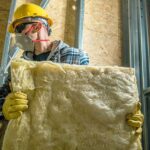In recent years, sustainability has dominated the commercial construction industry. As the environmental impact of traditional construction methods becomes increasingly apparent, architects, developers, and builders are pursuing innovative ways to make commercial buildings more eco-friendly. Utilization of sustainable materials is one of the movement’s main tenets. This blog will examine how sustainable materials are reshaping commercial construction and contributing to a greener, more sustainable future.
Why Sustainable Materials Are Essential
Before we venture into specific materials, let’s examine why sustainable materials are necessary in commercial construction. Long associated with resource depletion, excessive refuse production, and high energy consumption is the construction industry. Sustainable materials provide an alternative and mitigate these negative effects in a number of ways.
- Sustainable materials are sourced, produced, and transported with an emphasis on reducing their environmental footprint. This includes energy efficiency, emissions, and waste reduction considerations throughout their lifecycle.
- Energy Efficiency: Numerous eco-friendly materials have superior insulating qualities, thereby reducing a building’s energy consumption. This not only reduces operational expenses but also greenhouse gas emissions.
- Durability: Sustainable materials are frequently chosen because of their resistance to wear and strain. This will result in fewer replacements and less material waste over time.
- Because they emit fewer hazardous chemicals, sustainable materials are generally healthier for occupants. Improved indoor air quality contributes to the well-being of these commercial spaces’ occupants.
Sustainable Material Alternatives
- Utilizing recycled steel, reclaimed wood, and salvaged glass can substantially reduce the demand for new resources and reduce waste.
- The swiftly renewable resource bamboo can be used for flooring, furniture, and even structural elements. It matures rapidly and sequesters carbon as it expands.
- Volatile organic compounds (VOCs) present in paints and finishes can contribute to residential air pollution. Low-VOC alternatives provide a healthier alternative.
- Energy-Efficient Insulation: Materials such as recycled denim and spray foam insulation can increase the energy efficiency of a building, thereby reducing its heating and ventilation requirements.
- Solar Panels: Although not strictly a building material, incorporating solar panels into the design of a commercial building is a sustainable choice that generates pure, renewable energy.
Difficulties and Considerations
While the use of sustainable materials in commercial construction is on the rise, there are still obstacles to overcome. These include higher initial costs, limited availability, and compatibility concerns with existing structures. However, the long-term benefits of reduced operating costs, improved reputation, and environmental stewardship frequently outweigh these difficulties.
The conclusion
The transition toward sustainable materials in commercial construction is a major step toward greener and more environmentally responsible building practices. As societal awareness of the need for sustainable solutions grows, it is likely that the use of these materials will become the norm rather than the exception. Adopting sustainable materials is not merely a passing fad; it is a commitment to creating a more resilient and sustainable future for commercial real estate. We can create commercial spaces that are not only environmentally favorable but also economically and socially sustainable for future generations by making conscious decisions today.








